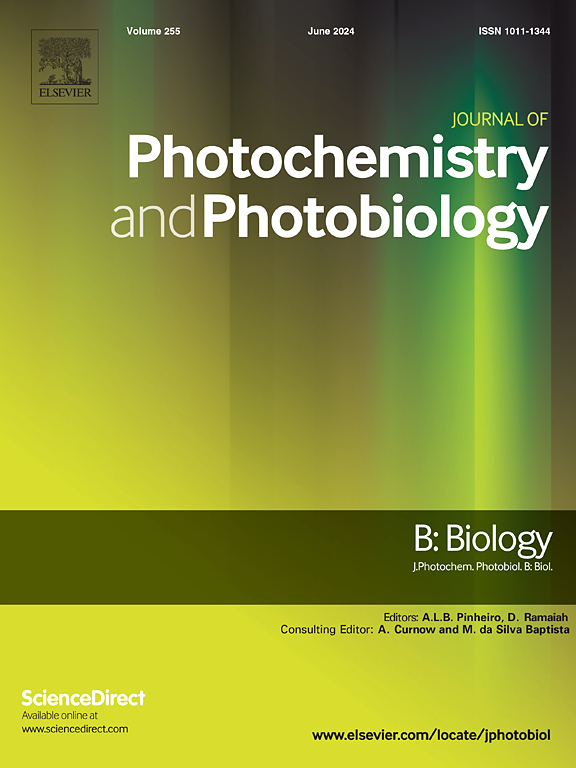Stimulating angiogenesis and post-ischemic tissue repair: Optimizing photobiomodulation parameters in vivo
IF 3.7
2区 生物学
Q2 BIOCHEMISTRY & MOLECULAR BIOLOGY
Journal of photochemistry and photobiology. B, Biology
Pub Date : 2025-06-24
DOI:10.1016/j.jphotobiol.2025.113202
引用次数: 0
Abstract
Photobiomodulation (PBM) therapy, a non-invasive therapeutic approach utilizing red and near-infrared light at sub-thermal irradiances, presents significant potential in promoting angiogenesis and tissue repair. This study optimized PBM parameters and evaluated its effects in three complementary models: the chicken embryo chorioallantoic membrane (CAM), the aortic ring assay, and the mouse hindlimb ischemia (HLI) model.
In the CAM model, PBM significantly enhanced vascular formation by increasing capillary branching and vessel density under optimized conditions. The aortic ring assay confirmed PBM's pro-angiogenic effects, demonstrating a marked increase in microvascular sprouting. In the mouse model, light propagation measurements at 652 nm and 730 nm were conducted to calculate attenuation coefficients for precise dosimetry. Daily PBM treatments at 652 nm following femoral artery ligation improved blood flow recovery at 14 days post-surgery. While minimal effects were observed at 5 days, likely attributable to initial hypoxia, PBM at 652 nm proved more efficient at 14 days, suggesting enhanced impact during later stages of vascular remodeling, when tissue oxygenation had improved.
This study highlights the importance of precise wavelength selection and dosimetry to maximize PBM's therapeutic efficacy. These findings demonstrate that PBM effectively enhances vascular remodeling and tissue repair as tissue oxygenation recovers, representing a promising strategy for promoting recovery in ischemic conditions.
刺激血管生成和缺血后组织修复:优化体内光生物调节参数
光生物调节(PBM)疗法是一种利用红光和近红外光进行亚热照射的非侵入性治疗方法,在促进血管生成和组织修复方面具有重要潜力。本研究优化了PBM的参数,并在鸡胚绒毛尿囊膜(CAM)、主动脉环实验和小鼠后肢缺血(HLI)三种互补模型中对其效果进行了评价。在CAM模型中,优化条件下PBM通过增加毛细血管分支和血管密度显著促进血管形成。主动脉环试验证实了PBM的促血管生成作用,显示微血管发芽明显增加。在小鼠模型中,进行了652 nm和730 nm的光传播测量,以计算精确剂量测定的衰减系数。股动脉结扎术后652nm处每日PBM治疗可改善术后14天血流恢复。虽然在第5天观察到的影响很小,可能是由于最初的缺氧,但在第14天,652nm的PBM被证明更有效,这表明在血管重塑的后期阶段,当组织氧合改善时,影响会增强。本研究强调了精确的波长选择和剂量测定对于最大限度地提高PBM的治疗效果的重要性。这些发现表明,随着组织氧合的恢复,PBM有效地增强了血管重塑和组织修复,代表了促进缺血性疾病恢复的有希望的策略。
本文章由计算机程序翻译,如有差异,请以英文原文为准。
求助全文
约1分钟内获得全文
求助全文
来源期刊
CiteScore
12.10
自引率
1.90%
发文量
161
审稿时长
37 days
期刊介绍:
The Journal of Photochemistry and Photobiology B: Biology provides a forum for the publication of papers relating to the various aspects of photobiology, as well as a means for communication in this multidisciplinary field.
The scope includes:
- Bioluminescence
- Chronobiology
- DNA repair
- Environmental photobiology
- Nanotechnology in photobiology
- Photocarcinogenesis
- Photochemistry of biomolecules
- Photodynamic therapy
- Photomedicine
- Photomorphogenesis
- Photomovement
- Photoreception
- Photosensitization
- Photosynthesis
- Phototechnology
- Spectroscopy of biological systems
- UV and visible radiation effects and vision.

 求助内容:
求助内容: 应助结果提醒方式:
应助结果提醒方式:


